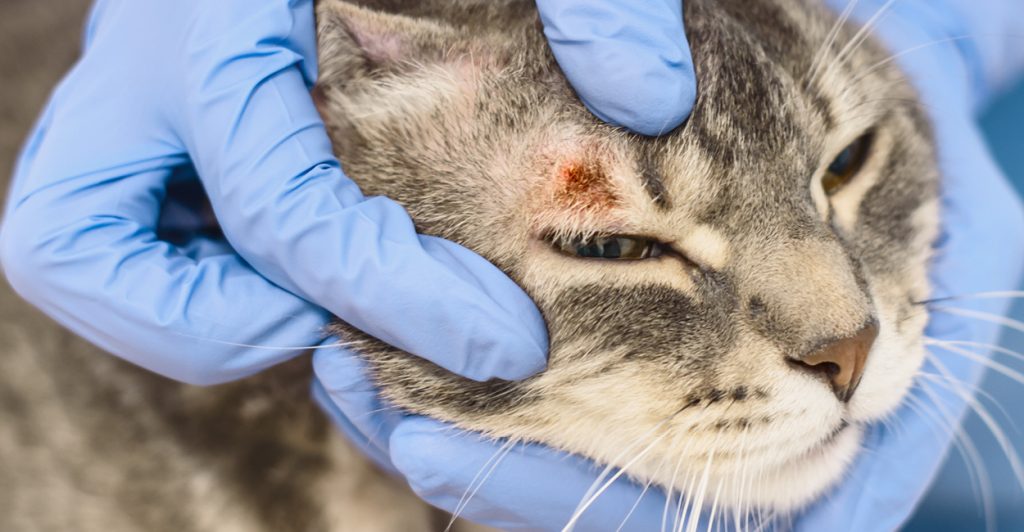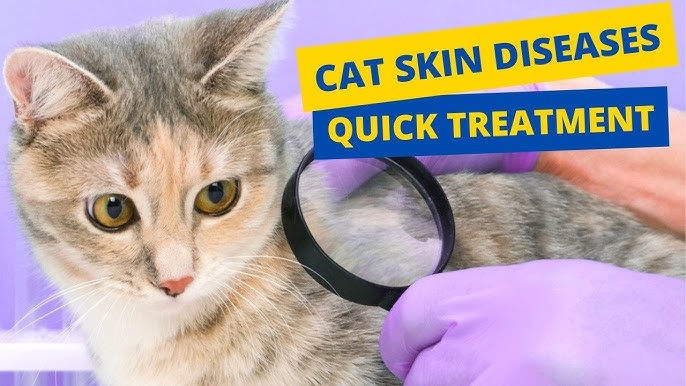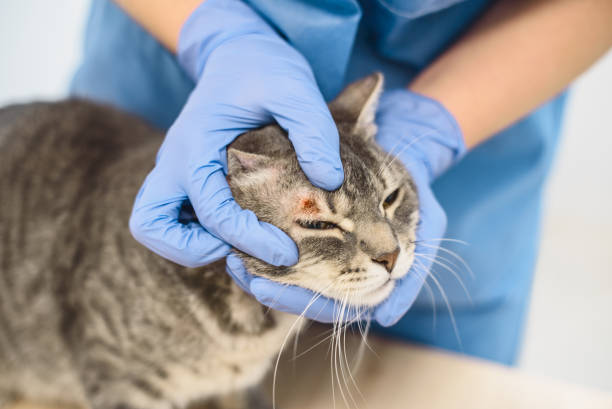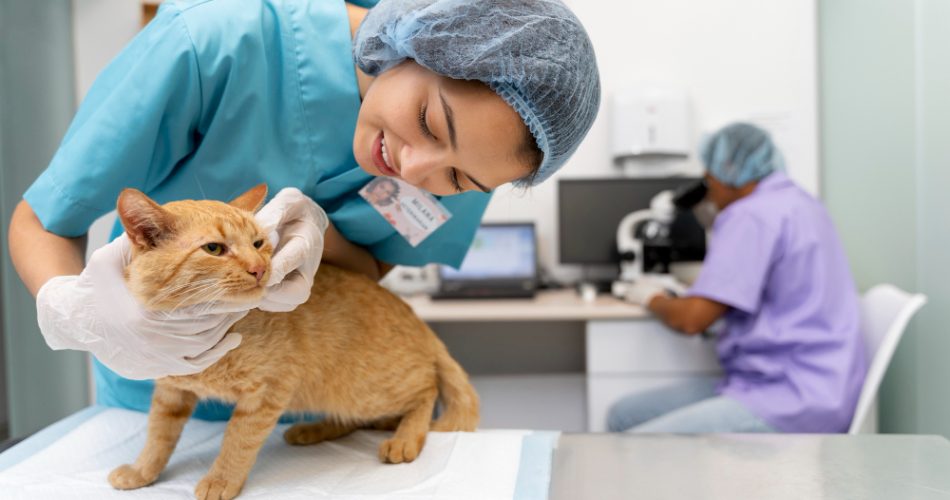Cats are known for their clean and often groomed appearances, but like any pet, they are susceptible to various skin conditions. Skin diseases in cats can cause discomfort, itching, hair loss, and even more serious health complications if not addressed properly. As a responsible cat owner, it’s essential to be aware of common skin diseases in cats, their symptoms, causes, and how to manage them to ensure your feline friend stays healthy and happy. In this post, we’ll explore some of the top skin conditions in cats and provide guidance on how to manage them effectively.
Fleas and Flea Allergic Dermatitis
Fleas are one of the most common external parasites that affect cats. Flea infestations can lead to intense itching, hair loss, and red, inflamed skin. Fleas are not only a nuisance, but they can also transmit various diseases to cats. Flea allergic dermatitis (FAD) is a hypersensitive reaction to flea saliva, which can cause severe itching and irritation even with a small number of fleas.
Symptoms of Fleas and FAD
If your cat is constantly scratching, biting, or licking their skin, especially around the back and base of the tail, fleas or FAD could be the cause. You may also notice flea dirt (small black specks) in their fur or on their bedding. In severe cases, hair loss and scabs may develop.
Managing Fleas and FAD
To manage flea infestations, regular flea prevention is key. Use flea treatments, such as spot-on treatments, oral medications, or flea collars, recommended by your veterinarian. Keeping your cat indoors and regularly cleaning their bedding and environment can help reduce the risk of fleas. For cats with flea allergic dermatitis, your vet may prescribe antihistamines, steroids, or other medications to control the itching and inflammation. Regular grooming will also help remove flea dirt and prevent further irritation.
Mites and Mange
Mites are microscopic parasites that can cause various skin conditions in cats. One common type of mite infestation is mange, which is caused by the Demodex or Sarcoptes mite. These tiny creatures burrow into the skin, leading to intense itching, hair loss, and scabs. There are two types of mange in cats: demodectic mange (often seen in young or immunocompromised cats) and sarcoptic mange (a more contagious form that can spread to other animals and humans).

Symptoms of Mites and Mange
The symptoms of mange include excessive scratching, hair loss, thickened skin, sores, and scabs. Cats with mange may also experience a dull, patchy coat. In some cases, secondary bacterial infections can develop due to scratching and skin damage.
Managing Mites and Mange
Treatment for mange generally involves medicated baths, topical treatments, or oral medications prescribed by your vet. Your veterinarian may also recommend antibiotics if secondary infections are present. In severe cases, multiple treatments may be necessary to eliminate the mites completely. To prevent reinfestation, keep your cat’s environment clean and ensure they receive regular veterinary care.
Ringworm (Fungal Infection)
Ringworm is a fungal infection that affects the skin, hair, and nails of cats. Despite its name, ringworm is not caused by a worm, but by a fungus that spreads through direct contact with an infected animal or contaminated environment. While ringworm is typically not life-threatening, it is highly contagious, both among cats and to humans.
Symptoms of Ringworm
Cats with ringworm may develop circular patches of hair loss with scaly, red, or inflamed skin. These patches may be itchy, and in some cases, the affected skin may appear dry and flaky. Cats with compromised immune systems, such as kittens or elderly cats, are more likely to develop severe cases of ringworm.
Managing Ringworm
If you suspect ringworm, your vet will likely conduct a fungal culture or microscopic exam of hair samples to confirm the diagnosis. Treatment typically involves antifungal medications, such as topical creams, shampoos, or oral antifungal drugs. It’s also important to clean your home thoroughly to prevent the spread of spores. Regularly disinfecting your cat’s bedding, grooming tools, and environment will help eliminate the fungus. Ringworm can be contagious to humans and other pets, so extra care should be taken during treatment.

Allergic Dermatitis
Allergic dermatitis is a general term used to describe inflammation of the skin caused by an allergic reaction. Cats can develop allergies to a variety of things, including food, pollen, dust mites, or certain grooming products. Fleas are also a common trigger for allergic dermatitis, causing itching and discomfort.
Symptoms of Allergic Dermatitis
The symptoms of allergic dermatitis include itching, red or inflamed skin, hair loss, and scabs. Cats with allergies may scratch or lick excessively, leading to secondary infections and further skin damage. The allergic reaction often affects areas like the face, paws, ears, and belly.
Managing Allergic Dermatitis
If you suspect that your cat has allergic dermatitis, it’s important to identify the source of the allergy. A veterinarian may perform tests to pinpoint the allergen. Once identified, avoiding the allergen is key to managing the condition. Your vet may also prescribe antihistamines, corticosteroids, or other medications to control itching and inflammation. In some cases, a special diet or topical treatments may be recommended to soothe irritated skin.
Hot Spots (Acute Moist Dermatitis)
Hot spots, also known as acute moist dermatitis, are localized areas of skin infection that become inflamed and infected due to excessive licking or scratching. Hot spots are usually triggered by something irritating the skin, such as allergies, insect bites, or infections. The moisture created by excessive licking and the presence of bacteria can make the condition worse.
Symptoms of Hot Spots
A hot spot typically appears as a red, inflamed, and moist patch of skin that may be covered in pus or scabs. It may be painful to the touch, and cats with hot spots may constantly lick or bite the affected area. These spots are most commonly found on the head, neck, and hindquarters.
Managing Hot Spots
To manage hot spots, it’s essential to stop your cat from licking or scratching the affected area. This may require using an Elizabethan collar to prevent further irritation. Your veterinarian will likely recommend topical treatments, such as antiseptic sprays or ointments, to help heal the area and prevent infection. In some cases, oral antibiotics may be prescribed if a bacterial infection is present. Identifying the underlying cause, such as allergies or flea infestations, is crucial to prevent future hot spots.
Dermatitis Due to Food Sensitivities
Food allergies or sensitivities can cause a variety of skin problems in cats, including itching, rashes, and hair loss. Cats may develop an allergic reaction to specific ingredients in their food, such as proteins, grains, or artificial additives. These reactions can result in chronic itching and discomfort.
Symptoms of Dermatitis Due to Food Sensitivities
Cats with food-related dermatitis often experience chronic itching, hair loss, and red or inflamed skin. The skin issues may be accompanied by gastrointestinal symptoms, such as vomiting or diarrhea.

Managing Dermatitis Due to Food Sensitivities
The first step in managing food allergies is to identify the ingredient causing the sensitivity. This is often done through an elimination diet, where your cat is fed a special food with limited ingredients to see if the symptoms improve. Once the allergen is identified, switching to a hypoallergenic or prescription diet can help alleviate symptoms. In some cases, your veterinarian may recommend additional treatments, such as antihistamines or corticosteroids, to manage inflammation.
Conclusion
Skin diseases in cats are common but manageable with prompt attention and the right treatment. Whether your cat is suffering from flea infestations, allergic reactions, fungal infections, or any other skin condition, identifying the symptoms early and seeking veterinary care is essential to ensuring your cat’s comfort and health. Regular grooming, proper nutrition, and routine veterinary checkups can also help prevent skin issues from becoming more severe. If you notice any changes in your cat’s skin, such as excessive scratching, hair loss, or scabs, consult your vet to determine the cause and find an appropriate treatment plan. Your cat’s skin health is an important part of their overall well-being, so taking proactive steps can lead to a happier, healthier pet.
